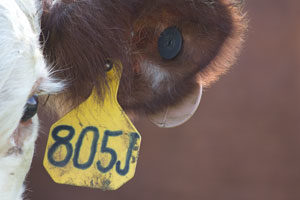Under the program, all cattle moved interstate would need to be officially identified and have documentation, including an interstate certificate of veterinary inspection, an owner-shipper statement or a brand certificate. Certain forms of ID can be approved – such as metal eartags – and allows states to agree upon their own alternative forms of ID, including brands or tattoos.
Vilsack said public forums held across the country, starting in 2009, revealed the need to adopt systems that are cost-effective and cohesive with state programs. But the country was lacking a viable traceability program that protects producers and consumers with clear information on at-risk animals when a disease event should arise.
“What we had before was a voluntary system that was not very well accepted by the industry,” Vilsack told reporters in a teleconference, saying participation was less than 35 percent. “One-size-fits-all didn’t fit in the marketplace or with producers and the uniqueness of each region of country. Each livestock sector is enabled by the new traceability program.”
Dr. John Clifford, U.S. chief veterinary officer, said the plan was built upon a state-federal cooperative effort to give maximum flexibility to local governments’ existing systems.
The traceability program is expected to cost $14.5 million in annual federal funding, Vilsack said, noting that congressional buy-in on the program would be critical given the ongoing debate over federal spending.
“We had indicated that it was our intention to partner with them, and cost of technology would not to be a burden to states or producers. So there will need to be support from Congress. We can make the case that the program can be better used and utilized. We spent a great deal of money in the past only to get meager participation.
“It makes common sense; if you have a disease incident, you want to be able to correct it as soon as possible and to focus and target the community that needs to be focused on rather than the larger segment. Hopefully people recognize the outreach effort.”
On global trade, Vilsack added that a traceability program “puts us in a much better competitive circumstance than we are in today. Other countries are using their traceability to get a market advantage. My belief is we’ll have greater compliance and greater confidence to do export marketing to other markets.”
On the issue of branding, Clifford said that ID practice will continue to be recognized as an official method in states that use it. But only 14 states use branding as an official ID form. So when livestock are sent interstate from a branding state to another state that doesn’t recognize branding, alternative methods of traceability will be required.
“To effectively have brandings to an efficient level, you have to have a system in place. If we allow brands to stay official we say to those 36 states you have to change a system that follows the others.”
The National Cattlemen’s Beef Association Chief Veterinarian Elizabeth Parker said the organization would keep working with APHIS to make sure cattlemen’s concerns are addressed in the new traceability program.
“We will carefully analyze and comment on APHIS’s proposed ADT rule. NCBA will continue to actively work with like-minded industry groups, state animal health officials and APHIS throughout the entire rulemaking process to ensure the best interests of our members.”
Bill Bullard, CEO and president of R-CALF USA, criticized the plan, saying it intends to remove branding and forces cattle under 18 months to be included in the program after the initial one-year introduction period.
“USDA officials have deceived livestock producers by pretending to seriously consider producer recommendations and then springing these unworkable and unacceptable mandates on us in its proposed rule,” Bullard said.
The rule was published in the August 11 Federal Register and is open to a 90-day comment period thereafter. The rules are available online at www.regulations.gov/#!documentDetail;D=APHIS-2009-0091. 
Photo by David Cooper:
Top right: ID tags are among the forms of official traceability methods recognized by the USDA in its latest rule proposals.









